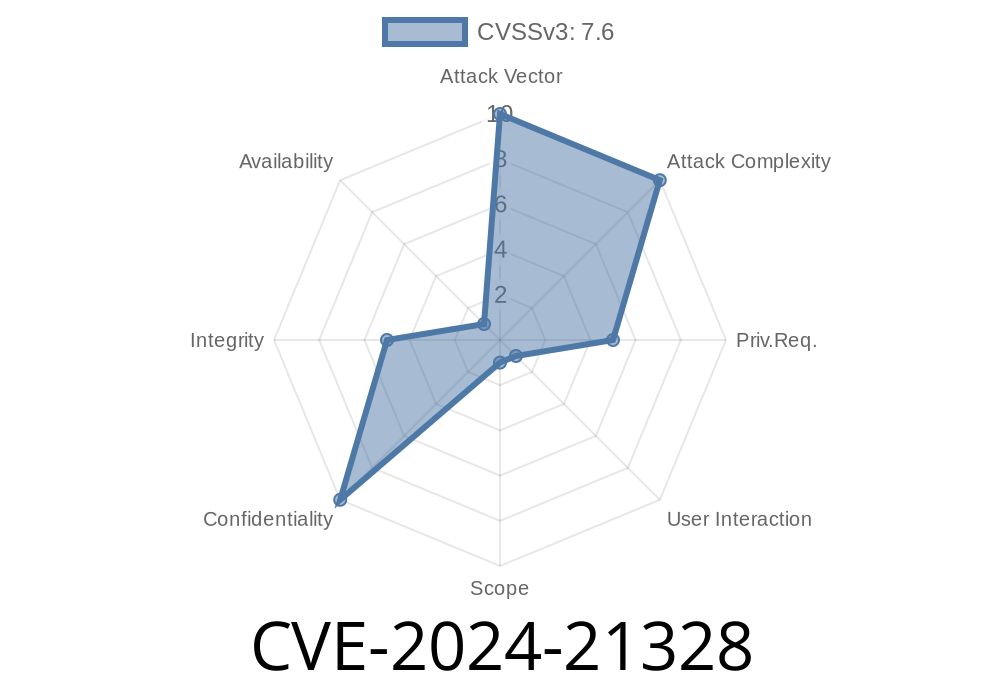In today's sophisticated cyber threat landscape, organizations need to be vigilant in their efforts to secure their software from malicious actors. One such vulnerability, known as the Dynamics 365 Sales Spoofing Vulnerability or CVE-2024-21328, has gained attention recently due to its ability to be exploited by cybercriminals. This post will provide specifics on this vulnerability, including code snippets, links to original references, and details on the potential exploit techniques.
What is CVE-2024-21328?
CVE-2024-21328 is a spoofing vulnerability that affects Microsoft Dynamics 365 Sales, one of the components in the Dynamics 365 software suite. Spoofing attacks involve an attacker impersonating another entity, often by forging certain identifiers or tampering with communications.
Dynamics 365 is a popular software suite that includes many tools, like customer relationship management (CRM), enterprise resource planning (ERP), and sales tools. As a result, cybercriminals can leverage this vulnerability to manipulate or forge information in a targeted system, making it difficult for users to trust that they are getting accurate information.
Vulnerability Details
The Dynamics 365 Sales spoofing vulnerability takes advantage of a weakness in the way that the application verifies the authenticity of certain pieces of data. By exploiting this vulnerability, attackers can forge credible-looking data or manipulate existing information in the system.
The following code snippet demonstrates an example of how attackers might exploit this vulnerability
# Exploit code sample
import requests
# Target Dynamics 365 Sales application URL
URL = "https://TARGET-DYNAMICS-365-SAAS-COMPANY.COM";
# Spoofed data
fake_data = {
"customer_name": "FakeCompanyName",
"sales_contacts": "FakeContactList",
"sales_opportunities": "FakeOpportunities",
}
# HTTP POST request to the trusted endpoint
response = requests.post(f"{URL}/api/v1/sales-integration", data=fake_data)
if response.status_code == 200:
print("Spoofing successful")
else:
print("Spoofing failed")
By altering input data and sending it via HTTP POST request, the attacker can potentially insert malicious information into the system, which then appears authentic to users.
Original References
For more information about the Dynamics 365 Sales Spoofing Vulnerability, you can refer to the original sources in which it was reported and confirmed:
1. MITRE, the organization that manages the CVE database, provides entry information on CVE-2024-21328: https://cve.mitre.org/cgi-bin/cvename.cgi?name=CVE-2024-21328
2. Microsoft's Security Update Guide provides details on the vulnerability and recommendations for Dynamics 365 Sales users: https://msrc.microsoft.com/update-guide/vulnerability/CVE-2024-21328
Exploit Details
Cybercriminals can exploit the Dynamics 365 Sales spoofing vulnerability in several ways, including but not limited to:
1. Inserting false sales leads into the system and causing salespeople to waste time and resources following up on non-existent opportunities.
2. Gaining unauthorized access to sensitive customer information and using it for illegal purposes, such as identity theft or phishing attacks.
3. Damaging the organization's reputation by tampering with customer satisfaction data or other critical metrics.
Mitigation Strategies
To protect against the Dynamics 365 Sales spoofing vulnerability, Microsoft has issued a security patch that resolves the issue. Organizations using Dynamics 365 Sales should ensure their software is up-to-date with the latest security patches by following Microsoft's guidelines: https://docs.microsoft.com/en-us/dynamics365/getting-started/checklist-security-privacy
Additionally, organizations can implement strong monitoring and access-control strategies to detect and deter potential spoofing attacks.
Conclusion
The CVE-2024-21328 Dynamics 365 Sales spoofing vulnerability highlights the importance of staying updated on current cybersecurity threats and applying relevant security patches in a timely manner. By understanding the potential risks and taking necessary precautions, organizations can minimize their exposure to these threats and maintain a more secure platform.
Timeline
Published on: 02/13/2024 18:15:48 UTC
Last modified on: 02/22/2024 15:28:31 UTC
